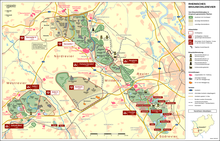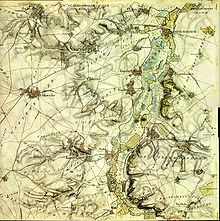Morken-Harff

Morken and Harff were places in the Rhein-Erft district in the administrative district of Cologne, which had to give way to open- cast lignite mining in the Rhenish lignite district . The residents of Morken-Harff were relocated to the neighboring Kaster in the 1960s .
history
The origins of the former places Morken and Harff near Bedburg an der Erft go back to the Neolithic . From 1966, the two places had to give way to lignite mining in the Frimmersdorf Süd opencast mine (today part of the Garzweiler opencast mine ). By the mid-1970s, around 1950 people from 407 houses / properties were relocated to Kaster . The clubs with their traditions were mainly taken away from the old twin town . The numerous old shooting clubs, some of which were founded in the 12th century, are remarkable.
The Martinus Church in Morken was demolished in 1974 and found a new site in Kaster. Today a large glass window by Paul Weigmann and the crucifixion group placed in front of it remind of the old homeland.

Archaeological finds
Excavations on the church hill in Morken brought to light, among others, the remains of a Roman country estate ( villa rustica ) from the time of the Colonia Claudia Ara Agrippinensium . There were also about 150 consecration stones for the Celtic-Roman-Germanic mother goddess Matronae Austriahenae ("The Easterners"). With the stones their donors thanked for the help of the matrons, the inscriptions usually contain the consecration formula “VSLM” (Votum Solvit Libens Merito): “The vow gladly and meritoriously fulfilled”.
The still untouched “Prince's grave” of Herr von Morken from the 6th century in an uncovered Franconian burial ground was the most important find with its rich furnishings that the excavations carried out by the Rheinisches Landesmuseum Bonn in 1955/56 in Morken brought to light. One of the numerous grave goods was the precious helmet of a nobleman . The helmet, made of iron and gilded bronze sheet , is 18 cm high and its largest diameter is 22.5 cm. Information about this and important parts of the find belong to the permanent exhibition of the Rheinisches Landesmuseum in Bonn.
Location description


The double location consisted of the Harff Castle with its chapel and the mill, the town of Harff , which consisted of a row of a few small courtyards and cottages on the street side opposite the castle, and the clustered village of Morken , which had its own train station on the Düren– Neuss , the Martinus Church and the miners' settlements built later made up the main part of the double town. This also included the small hamlet of Omagen , which essentially consisted of the Omagen Castle, which existed until 1935, two courtyards and the restaurant belonging to the zoo. About 1000 m east of Morken on the Erft was the Huster Knupp , a so-called Motte , which was the ancestral seat of the County of Hochstaden (Huster) . The church was built in 1894/95 according to sketches by Heinrich Wiethase - and after his death with plans by Theodor Roß - by Heinrich Wolf from Elsdorf in the neo-Romanesque style between the two places. The previous old church on the church hill from the 11th century had long been dilapidated and had to be supported as early as 1875.
literature
- Der Erftkreis (ed.): Documentation of a resettlement site. Commemorative publication for the 800th anniversary of the Morken-Harff 1200 eV citizens' shooting association
Web links
- Harff in pictures
- Wiki entry: Morken-Harff. In: GenWiki . July 13, 2010, accessed October 17, 2013 (with pictures and maps).
- Royal Preuss.-Land survey: Grevenbroich (topographic map from 1899, sheet 4905). University of Greifswald , accessed on October 17, 2013 .
Individual evidence
- ↑ The Erft was first relocated in the Morken-Harff area as early as 1941/42, see Peter Zenker: Brown coal mining in Frimmersdorf. Own publication , Siegburg 2007, p. 84 ( PDF; 5.7 MB; 101 pages in peter-zenker.de ).
- ^ Peter Zenker: Lignite mining in Frimmersdorf. Own publication, Siegburg 2007, p. 77 ( PDF; 5.7 MB; 101 pages in peter-zenker.de ).
- ↑ Jürgen Bartel, Reinhart Zschocke: The Ville and the Rhenish brown coal area. In: Kölner Bucht and adjacent areas (= Geographical Guide. Volume 6). Bornträger, Stuttgart / Berlin 1972, p. 76 and 78.
- ^ Part of the story after Rainer Görres: Morken-Harff: Impressions of the lost home. ( Memento of the original from March 4, 2016 in the Internet Archive ) Info: The archive link was inserted automatically and has not yet been checked. Please check the original and archive link according to the instructions and then remove this notice. St. Sebastianus Bürger-Schützenbruderschaft Morken-Harff 1200 eV, September 6, 2010, accessed on October 17, 2013.
- ↑ hc: memory of the excavated home. Kölner Stadt-Anzeiger , November 26, 2009, accessed October 17, 2013.
- ↑ Hans Broisch: The Martinskirche in the resettlement area Morken-Harff. ( Memento of the original from October 22, 2013 in the Internet Archive ) Info: The archive link was automatically inserted and not yet checked. Please check the original and archive link according to the instructions and then remove this notice. Archdiocese of Cologne , undated, accessed on October 17, 2013.
- ↑ Rudolf Simek: Gods and Cults of the Teutons. 2nd Edition. CH Beck, Munich 2006, p. 52 ( side view in the Google book search): "[...] about 150 stones were found in Morken-Harff on the Matronae Austriahenae (" the eastern ones ") [...]".
- ↑ Frank Dießenbacher: The Lord of Morken. Reconstruction of the grave of a Frankish nobleman. In: Dießenbacher Informationsmedien. 2001–2013, accessed October 17, 2013.